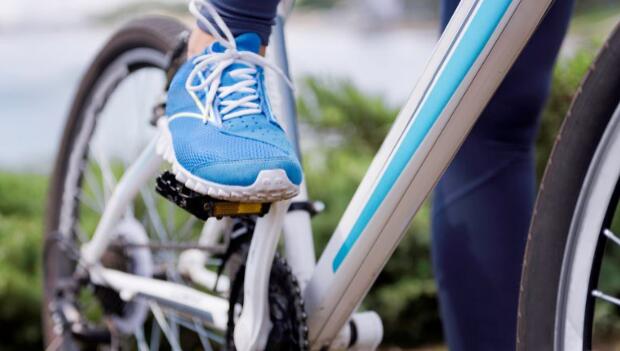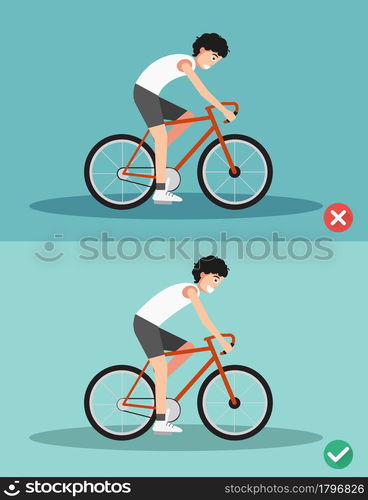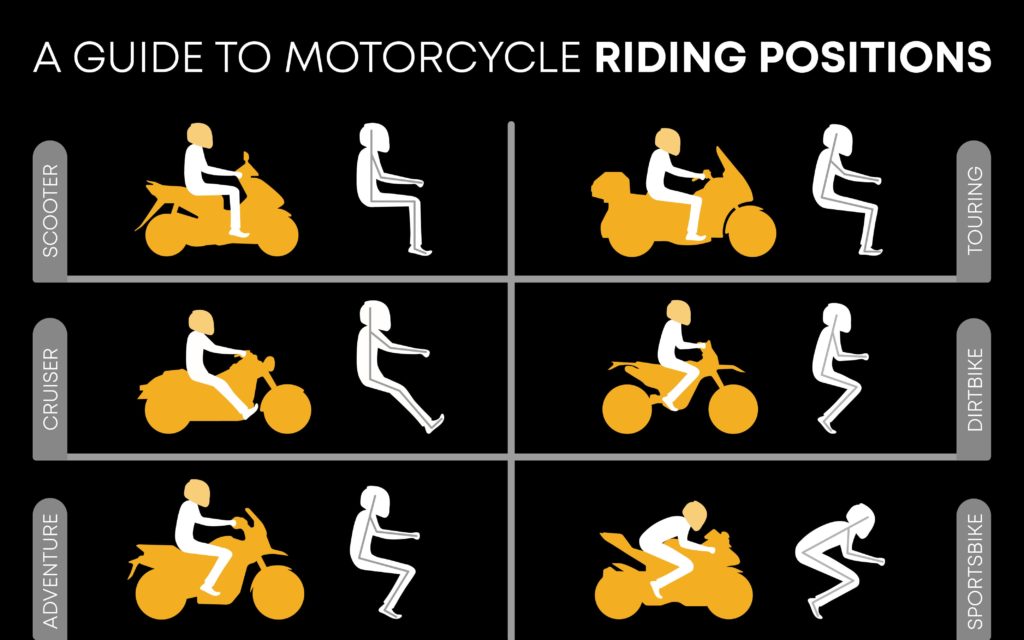Why Proper Bike Positioning Matters
Maintaining a correct position on a bike is crucial for a comfortable and efficient ride. When a cyclist’s body is properly aligned with the bike, it can significantly reduce discomfort, improve efficiency, and enhance the overall cycling experience. A well-fitted bike position can also help prevent injuries, such as back and neck strain, and improve performance by allowing the rider to generate more power and speed.
A correct position on a bike can also improve the rider’s aerodynamics, reducing air resistance and allowing them to cut through the wind with ease. This is particularly important for competitive cyclists, where every second counts. Additionally, a proper bike position can help reduce fatigue, allowing riders to ride for longer periods without feeling exhausted.
Furthermore, a correct position on a bike can also improve the rider’s safety. When a cyclist is properly positioned on the bike, they are more likely to be aware of their surroundings and able to react quickly to potential hazards. This is especially important for riders who commute in heavy traffic or ride in low-light conditions.
Overall, maintaining a correct position on a bike is essential for a comfortable, efficient, and safe ride. By taking the time to adjust their bike position, cyclists can improve their performance, reduce their risk of injury, and enhance their overall cycling experience.
Understanding Your Body Position: Key Elements to Consider
When it comes to finding a correct position on a bike, there are several key elements to consider. These elements work together to provide a comfortable and efficient ride, and making adjustments to them can have a significant impact on a cyclist’s overall experience.
One of the most critical elements of proper bike positioning is saddle height. A saddle that is too high or too low can cause discomfort, reduce efficiency, and even lead to injury. To determine the optimal saddle height, cyclists can use a bike fit calculator or consult a professional bike fitter. These tools can help identify the ideal saddle height based on the rider’s leg length, inseam, and riding style.
Another essential element of proper bike positioning is handlebar height and reach. Handlebars that are too far forward or backward can cause strain on the neck, back, and shoulders, leading to discomfort and fatigue. Cyclists can adjust the handlebar height and reach by changing the stem length or angle, or by using a handlebar with a different shape or design.
Foot position is also a critical element of proper bike positioning. A foot position that is too far forward or backward can cause discomfort, reduce efficiency, and even lead to injury. Cyclists can adjust the foot position by changing the cleat position or using a different type of pedal.
By understanding and adjusting these key elements, cyclists can find a correct position on a bike that provides a comfortable and efficient ride. This can help reduce discomfort, improve performance, and enhance the overall cycling experience.
How to Achieve the Perfect Saddle Height
Adjusting the saddle height is a crucial step in finding a correct position on a bike. A saddle that is too high or too low can cause discomfort, reduce efficiency, and even lead to injury. To determine the optimal saddle height, follow these steps:
1. Start by standing over the bike with your feet shoulder-width apart. The saddle should be at a height that allows you to put both feet flat on the ground with your leg almost fully extended.
2. Next, sit on the saddle and place your foot on the pedal. The leg should be almost fully extended, with a slight bend in the knee.
3. Check the saddle height by looking for a slight bend in the knee when the pedal is in its lowest position. If the knee is fully extended or bent too far, the saddle height needs to be adjusted.
4. Use a bike fit calculator or consult a professional bike fitter to determine the optimal saddle height based on your leg length, inseam, and riding style.
5. Make adjustments to the saddle height in small increments, checking the fit after each adjustment. It’s better to err on the side of caution and make small adjustments rather than making large changes that may affect the overall fit.
By following these steps, you can achieve the perfect saddle height and find a correct position on a bike that provides a comfortable and efficient ride.
Handlebar Height and Reach: Finding Your Ideal Position
Proper handlebar height and reach are essential for a comfortable and efficient ride. When the handlebars are too far forward or backward, it can cause strain on the neck, back, and shoulders, leading to discomfort and fatigue. On the other hand, when the handlebars are at the correct height and reach, it can help reduce strain and improve overall comfort and performance.
To find the ideal handlebar height and reach, consider the following tips:
1. Start by standing over the bike with your feet shoulder-width apart. The handlebars should be at a height that allows you to maintain a slight bend in the elbows and a neutral spine.
2. Adjust the handlebar height by changing the stem length or angle. A longer stem can provide more reach, while a shorter stem can provide less reach.
3. Consider the type of riding you will be doing. For example, if you will be riding in a more upright position, you may want to adjust the handlebars to be higher and closer to your body.
4. Experiment with different handlebar positions to find what works best for you. Pay attention to how your body feels and make adjustments as needed.
By finding the ideal handlebar height and reach, you can reduce strain on your neck, back, and shoulders, and improve overall comfort and performance. This can help you ride more efficiently and enjoy your time on the bike.
Foot Position and Pedaling Technique: Optimizing Your Ride
Proper foot position and pedaling technique are essential for a comfortable and efficient ride. When the feet are in the correct position and the pedaling technique is optimized, it can help reduce discomfort, improve efficiency, and enhance overall cycling performance.
To optimize foot position, consider the following tips:
1. Make sure the cleats are properly aligned with the pedals. This will help ensure that the feet are in the correct position and that the pedaling motion is smooth and efficient.
2. Experiment with different foot positions to find what works best for you. Some riders prefer a more forward or backward foot position, while others prefer a more neutral position.
3. Consider the type of pedals and shoes you are using. Different types of pedals and shoes can affect the foot position and pedaling technique.
To optimize pedaling technique, consider the following tips:
1. Focus on using the correct muscles to pedal. The legs should be doing most of the work, with the core and upper body providing support and stability.
2. Practice pedaling with a smooth and efficient motion. Avoid mashing the pedals or using too much force, as this can lead to fatigue and discomfort.
3. Experiment with different cadences to find what works best for you. A higher cadence can help improve efficiency and reduce discomfort, while a lower cadence can help build strength and endurance.
By optimizing foot position and pedaling technique, riders can improve their overall comfort and efficiency on the bike. This can help reduce discomfort, improve performance, and enhance the overall cycling experience.
Common Mistakes to Avoid: Bike Positioning Errors to Watch Out For
When it comes to bike positioning, there are several common mistakes to avoid. These mistakes can lead to discomfort, reduced efficiency, and even injury. By being aware of these common mistakes, riders can take steps to avoid them and find a correct position on a bike that provides a comfortable and efficient ride.
One common mistake is a saddle height that is too high or too low. A saddle that is too high can cause the rider to overstretch and put strain on the back and shoulders, while a saddle that is too low can cause the rider to feel cramped and uncomfortable.
Another common mistake is handlebars that are too far forward or backward. Handlebars that are too far forward can cause the rider to lean forward and put strain on the neck and shoulders, while handlebars that are too far backward can cause the rider to lean backward and put strain on the back and shoulders.
Foot position is also a common area for mistakes. A foot position that is too far forward or backward can cause the rider to feel uncomfortable and can lead to reduced efficiency and performance.
Additionally, riders should avoid making drastic changes to their bike position without proper guidance. This can lead to discomfort, reduced efficiency, and even injury. Instead, riders should make gradual changes and seek professional advice if needed.
By being aware of these common mistakes and taking steps to avoid them, riders can find a correct position on a bike that provides a comfortable and efficient ride. This can help reduce discomfort, improve performance, and enhance the overall cycling experience.
Real-World Examples: How Professional Cyclists Optimize Their Bike Position
Professional cyclists understand the importance of finding a correct position on a bike for optimal comfort and performance. Here are some real-world examples of how professional cyclists optimize their bike position:
Chris Froome, a four-time Tour de France winner, is known for his attention to detail when it comes to his bike position. He works closely with his team’s bike fitter to ensure that his saddle height, handlebar height, and foot position are all optimized for his riding style.
Peter Sagan, a three-time world champion, is another example of a professional cyclist who takes his bike position seriously. He has been known to spend hours in the wind tunnel, fine-tuning his bike position to reduce aerodynamic drag and improve his overall performance.
Other professional cyclists, such as Geraint Thomas and Egan Bernal, also prioritize their bike position as part of their training and preparation. They understand that a correct position on a bike can make all the difference in terms of comfort, efficiency, and performance.
By studying the bike positions of professional cyclists, riders can gain valuable insights into how to optimize their own bike position for comfort and performance. Whether it’s adjusting the saddle height, handlebar height, or foot position, making small changes to the bike position can have a significant impact on the overall riding experience.
Conclusion: Finding Your Perfect Riding Position for a More Comfortable and Efficient Ride
As we’ve discussed throughout this article, finding a correct position on a bike is crucial for a comfortable and efficient ride. By understanding the key elements of proper bike positioning, including saddle height, handlebar height, and foot position, riders can make adjustments to optimize their bike position for comfort and performance.
Remember, finding the perfect riding position is a process that requires patience, experimentation, and attention to detail. Don’t be afraid to try different positions and seek professional advice if needed. With a little practice and persistence, you can find a correct position on a bike that provides a comfortable and efficient ride.
By following the tips and guidelines outlined in this article, riders can optimize their bike position for comfort and performance. Whether you’re a seasoned cyclist or just starting out, finding a correct position on a bike is essential for a enjoyable and efficient ride.
In conclusion, finding a correct position on a bike is a critical aspect of cycling that can make all the difference in terms of comfort, efficiency, and performance. By understanding the key elements of proper bike positioning and making adjustments as needed, riders can optimize their bike position for a more comfortable and efficient ride.








